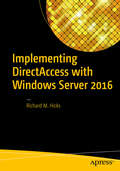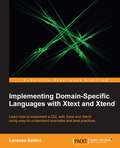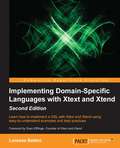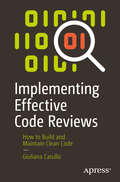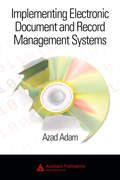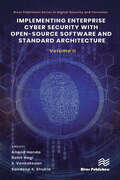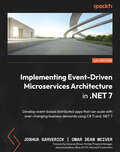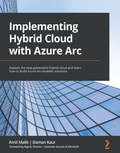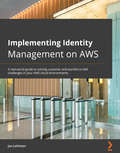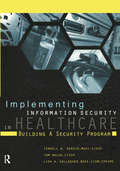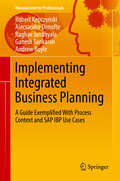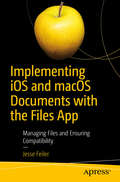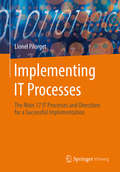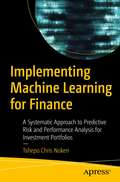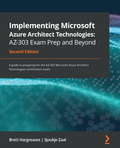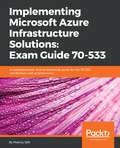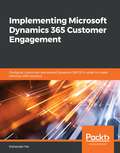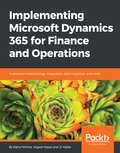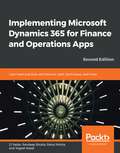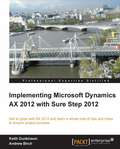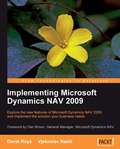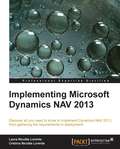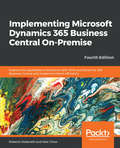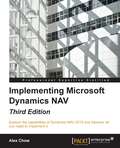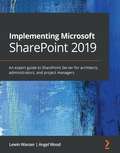- Table View
- List View
Implementing DirectAccess with Windows Server 2016
by Richard M. HicksLearn how to design, plan, implement, and support a secure remote access solution using DirectAccess in Windows Server 2016. Remote Access has been included in the Windows operating system for many years. With each new operating system release, new features and capabilities have been included to allow network engineers and security administrators to provide remote access in a secure and cost-effective manner. DirectAccess in Windows Server 2016 provides seamless and transparent, always on remote network connectivity for managed Windows devices. DirectAccess is built on commonly deployed Windows platform technologies and is designed to streamline and simplify the remote access experience for end users. In addition, DirectAccess connectivity is bidirectional, allowing administrators to more effectively manage and secure their field-based assets. Implementing DirectAccess with Windows Server 2016 provides a high-level overview of how DirectAccess works. The vision and evolution of DirectAccess are outlined and business cases and market drivers are explained. DirectAccess is evaluated against traditional VPN and this book describes the Windows platform technologies that underpin this solution. In addition, this book: Explains how the technology works and the specific IT pain points that it addressesIncludes detailed, prescriptive guidance for those tasked with implementing DirectAccess using Windows Server 2016Addresses real-world deployment scenarios for small and large organizationsContains valuable tips, tricks, and implementation best practices for security and performance What you ll learn A high-level understanding of the various remote access technologies included in Windows Server 2016. Common uses cases for remote access, and how best to deploy them in a secure, stable, reliable, and highly available manner. Valuable insight in to design best practices and learn how to implement DirectAccess and VPN with Windows Server 2016 according to deployment best practices. Who This Book Is For IT administrators, network, and security administrators and engineers, systems management professionals, compliance auditors, and IT executive management (CIO, CISO) are the target audience for this title. "
Implementing Domain-Specific Languages with Xtext and Xtend
by Lorenzo BettiniA step-by-step guide that enables you to quickly implement a DSL with Xtext and Xtend in a test-driven way with the aid of simplified examples.This book is for programmers who want to learn about Xtext and how to use it to implement a DSL (or a programming language) together with Eclipse IDE tooling. It assumes that the user is familiar with Eclipse and its functionality. Existing basic knowledge of a compiler implementation would be useful, though not strictly required, since the book will explain all the stages of the development of a DSL.
Implementing Domain-Specific Languages with Xtext and Xtend - Second Edition
by Lorenzo BettiniLearn how to implement a DSL with Xtext and Xtend using easy-to-understand examples and best practices About This Book * Leverage the latest features of Xtext and Xtend to develop a domain-specific language. * Integrate Xtext with popular third party IDEs and get the best out of both worlds. * Discover how to test a DSL implementation and how to customize runtime and IDE aspects of the DSL Who This Book Is For This book is targeted at programmers and developers who want to create a domain-specific language with Xtext. They should have a basic familiarity with Eclipse and its functionality. Previous experience with compiler implementation can be helpful but is not necessary since this book will explain all the development stages of a DSL. What You Will Learn * Write Xtext grammar for a DSL; * Use Xtend as an alternative to Java to write cleaner, easier-to-read, and more maintainable code; * Build your Xtext DSLs easily with Maven/Tycho and Gradle; * Write a code generator and an interpreter for a DSL; * Explore the Xtext scoping mechanism for symbol resolution; * Test most aspects of the DSL implementation with JUnit; * Understand best practices in DSL implementations with Xtext and Xtend; * Develop your Xtext DSLs using Continuous Integration mechanisms; * Use an Xtext editor in a web application In Detail Xtext is an open source Eclipse framework for implementing domain-specific languages together with IDE functionalities. It lets you implement languages really quickly; most of all, it covers all aspects of a complete language infrastructure, including the parser, code generator, interpreter, and more. This book will enable you to implement Domain Specific Languages (DSL) efficiently, together with their IDE tooling, with Xtext and Xtend. Opening with brief coverage of Xtext features involved in DSL implementation, including integration in an IDE, the book will then introduce you to Xtend as this language will be used in all the examples throughout the book. You will then explore the typical programming development workflow with Xtext when we modify the grammar of the DSL. Further, the Xtend programming language (a fully-featured Java-like language tightly integrated with Java) will be introduced. We then explain the main concepts of Xtext, such as validation, code generation, and customizations of runtime and UI aspects. You will have learned how to test a DSL implemented in Xtext with JUnit and will progress to advanced concepts such as type checking and scoping. You will then integrate the typical Continuous Integration systems built in to Xtext DSLs and familiarize yourself with Xbase. By the end of the book, you will manually maintain the EMF model for an Xtext DSL and will see how an Xtext DSL can also be used in IntelliJ. Style and approach A step-by step-tutorial with illustrative examples that will let you master using Xtext and implementing DSLs with its custom language, Xtend.
Implementing Effective Code Reviews: How to Build and Maintain Clean Code
by Giuliana CarulloThe ideal code review process differs from organization to organization, but the needs all boil down to the same foundational factors. A software development team cannot properly grow if its code reviews are not consistent, straightforward, and aspire to hit several company goals at once, such as security, performance, longevity, and more. Implementing Effective Code Reviews is the manual your team has been seeking. Author Giuliana Carullo uses her expert background to guide you through the basics of building and maintaining clean code, and she is known for distilling complex concepts into entertaining and easy-to-grasp lessons. Healthy code requires incremental improvements, and knowing how to execute this is essential for conducting effective reviews on your team. While complex and fancy code can be interesting to work with, it will not always achieve business goals or solve urgent problems. Good coding practices are at the heart of a high-performing team, and Carullo instills these core values in a simple, straight-forward way in Implementing Effective Code Reviews. Whether you are a passionate programmer looking to go the extra mile at the office, or an experienced software engineer seeking a guide to how to improve your leadership and code review process, this book covers it all. With each chapter wrapped up in a handy checklist of crucial takeaways, Carullo has created an essential handbook for coders everywhere. There are a lot of myths that dominate the programming landscape, and Implementing Effective Code Reviews grounds the process and gets to the heart of the matter. What You Will LearnUnderstand how to work with your team to implement effective code reviewsMaster good programming practices that will build healthy codeDiscover how you should tackle different complex areas during code review like, security and performance Who This Book Is ForPassionate programmers willing to go the extra mile to be better at their jobs, new programmers looking to strengthen their programming skills, and experienced software engineers looking for a quick guide on how to review code
Implementing Electronic Document and Record Management Systems
by Azad AdamThe global shift toward delivering services online requires organizations to evolve from using traditional paper files and storage to more modern electronic methods. There has however been very little information on just how to navigate this change-until now. Implementing Electronic Document and Record Management Systems explains how to efficiently
Implementing Enterprise Cyber Security with Open-Source Software and Standard Architecture: Volume II (River Publishers Series in Digital Security and Forensics)
by Anand Handa Rohit Negi S. Venkatesan Sandeep K. ShuklaCyber security is one of the most critical problems faced by enterprises, government organizations, education institutes, small and medium scale businesses, and medical institutions today. Creating a cyber security posture through proper cyber security architecture, deployment of cyber defense tools, and building a security operation center are critical for all such organizations given the preponderance of cyber threats. However, cyber defense tools are expensive, and many small and medium-scale business houses cannot procure these tools within their budgets. Even those business houses that manage to procure them cannot use them effectively because of the lack of human resources and the knowledge of the standard enterprise security architecture. In 2020, the C3i Center at the Indian Institute of Technology Kanpur developed a professional certification course where IT professionals from various organizations go through rigorous six-month long training in cyber defense. During their training, groups within the cohort collaborate on team projects to develop cybersecurity solutions for problems such as malware analysis, threat intelligence collection, endpoint detection and protection, network intrusion detection, developing security incidents, event management systems, etc. All these projects leverage open-source tools, and code from various sources, and hence can be also constructed by others if the recipe to construct such tools is known. It is therefore beneficial if we put these recipes out in the form of book chapters such that small and medium scale businesses can create these tools based on open-source components, easily following the content of the chapters. In 2021, we published the first volume of this series based on the projects done by cohort 1 of the course. This volume, second in the series has new recipes and tool development expertise based on the projects done by cohort 3 of this training program. This volume consists of nine chapters that describe experience and know-how of projects in malware analysis, web application security, intrusion detection system, and honeypot in sufficient detail so they can be recreated by anyone looking to develop home grown solutions to defend themselves from cyber-attacks.
Implementing Event-Driven Microservices Architecture in .NET 7: Develop event-based distributed apps that can scale with ever-changing business demands using C# 11 and .NET 7
by Joshua Garverick Omar Dean McIverImplement modern design patterns that leverage domain-driven data, to achieve resiliency and scalability for data-dependent applicationsKey FeaturesLearn the tenets of event-driven architecture, coupled with reliable design patterns to enhance your knowledge of distributed systems and build a foundation for professional growthUnderstand how to translate business goals and drivers into a domain model that can be used to develop an app that enables those goals and driversIdentify areas to enhance development and ensure operational support through the architectural design processBook DescriptionThis book will guide you through various hands-on practical examples for implementing event-driven microservices architecture using C# 11 and .NET 7. It has been divided into three distinct sections, each focusing on different aspects of this implementation.The first section will cover the new features of .NET 7 that will make developing applications using EDA patterns easier, the sample application that will be used throughout the book, and how the core tenets of domain-driven design (DDD) are implemented in .NET 7.The second section will review the various components of a local environment setup, the containerization of code, testing, deployment, and the observability of microservices using an EDA approach.The third section will guide you through the need for scalability and service resilience within the application, along with implementation details related to elastic and autoscale components. You'll also cover how proper telemetry helps to automatically drive scaling events. In addition, the topic of observability is revisited using examples of service discovery and microservice inventories.By the end of this book, you'll be able to identify and catalog domains, events, and bounded contexts to be used for the design and development of a resilient microservices architecture.What you will learnExplore .NET 7 and how it enables the development of applications using EDAUnderstand messaging protocols and producer/consumer patterns and how to implement them in .NET 7Test and deploy applications written in .NET 7 and designed using EDA principlesAccount for scaling and resiliency in microservicesCollect and learn from telemetry at the platform and application levelGet to grips with the testing and deployment of microservicesWho this book is forThis book will help .NET developers and architects looking to leverage or pivot to microservices while using a domain-driven event model.
Implementing Hybrid Cloud with Azure Arc: Explore the new-generation hybrid cloud and learn how to build Azure Arc-enabled solutions
by Amit Malik Daman Kaur Raja NAccelerate hybrid cloud innovation using Azure Arc with the help of real-world scenarios and examplesKey FeaturesGet to grips with setting up and working with Azure ArcHarness the power of Azure Arc and its integration with cutting-edge technologies such as Kubernetes and PaaS data servicesManage, govern, and monitor your on-premises servers and applications with AzureBook DescriptionWith all the options available for deploying infrastructure on multi-cloud platforms and on-premises comes the complexity of managing it, which is adeptly handled by Azure Arc. This book will show you how you can manage environments across platforms without having to migrate workloads from on-premises or multi-cloud to Azure every time. Implementing Hybrid Cloud with Azure Arc starts with an introduction to Azure Arc and hybrid cloud computing, covering use cases and various supported topologies. You'll learn to set up Windows and Linux servers as Arc-enabled machines and get to grips with deploying applications on Kubernetes clusters with Azure Arc and GitOps. The book then demonstrates how to onboard an on-premises SQL Server infrastructure as an Arc-enabled SQL Server and deploy and manage a hyperscale PostgreSQL infrastructure on-premises through Azure Arc. Along with deployment, the book also covers security, backup, migration, and data distribution aspects. Finally, it shows you how to deploy and manage Azure's data services on your own private cloud and explore multi-cloud solutions with Azure Arc. By the end of this book, you'll have a firm understanding of Azure Arc and how it interacts with various cutting-edge technologies such as Kubernetes and PaaS data services.What you will learnSet up a fully functioning Azure Arc-managed environmentExplore products and services from Azure that will help you to leverage Azure ArcUnderstand the new vision of working with on-premises infrastructureDeploy Azure's PaaS data services on-premises or on other cloud platformsDiscover and learn about the technologies required to design a hybrid and multi-cloud strategyImplement best practices to govern your IT infrastructure in a scalable modelWho this book is forThis book is for Cloud IT professionals (Azure and/or AWS), system administrators, database administrators (DBAs), and architects looking to gain clarity about how Azure Arc works and how it can help them achieve business value. Anyone with basic Azure knowledge will benefit from this book.
Implementing Identity Management on AWS: A real-world guide to solving customer and workforce IAM challenges in your AWS cloud environments
by Jon Lehtinen Steve "Hutch" HutchinsonUnderstand the IAM toolsets, capabilities, and paradigms of the AWS platform and learn how to apply practical identity use cases to AWS at the administrative and application levelKey FeaturesLearn administrative lifecycle management and authorizationExtend workforce identity to AWS for applications deployed to Amazon Web Services (AWS)Understand how to use native AWS IAM capabilities with apps deployed to AWSBook DescriptionAWS identity management offers a powerful yet complex array of native capabilities and connections to existing enterprise identity systems for administrative and application identity use cases. This book breaks down the complexities involved by adopting a use-case-driven approach that helps identity and cloud engineers understand how to use the right mix of native AWS capabilities and external IAM components to achieve the business and security outcomes they want.You will begin by learning about the IAM toolsets and paradigms within AWS. This will allow you to determine how to best leverage them for administrative control, extending workforce identities to the cloud, and using IAM toolsets and paradigms on an app deployed on AWS. Next, the book demonstrates how to extend your on-premise administrative IAM capabilities to the AWS backplane, as well as how to make your workforce identities available for AWS-deployed applications. In the concluding chapters, you'll learn how to use the native identity services with applications deployed on AWS.By the end of this IAM Amazon Web Services book, you will be able to build enterprise-class solutions for administrative and application identity using AWS IAM tools and external identity systems.What you will learnUnderstand AWS IAM concepts, terminology, and servicesExplore AWS IAM, Amazon Cognito, AWS SSO, and AWS Directory Service to solve customer and workforce identity problemsApply the concepts you learn about to solve business, process, and compliance challenges when expanding into AWSNavigate the AWS CLI to unlock the programmatic administration of AWSExplore how AWS IAM, its policy objects, and notational language can be applied to solve security and access management use casesRelate concepts easily to your own environment through IAM patterns and best practicesWho this book is forIdentity engineers and administrators, cloud administrators, security architects, or anyone who wants to explore and manage IAM solutions in AWS will find this book useful. Basic knowledge of AWS cloud infrastructure and services is required to understand the concepts covered in the book more effectively.
Implementing Information Security in Healthcare: Building a Security Program (HIMSS Book Series)
by Terrell Herzig Tom WalshImplementing Information Security in Healthcare: Building a Security Program offers a critical and comprehensive look at healthcare security concerns in an era of powerful computer technology, increased mobility, and complex regulations designed to protect personal information. Featuring perspectives from more than two dozen security experts, the book explores the tools and policies healthcare organizations need to build an effective and compliant security program. Topics include information security frameworks, risk analysis, senior management oversight and involvement, regulations, security policy development, access control, network security, encryption, mobile device management, disaster recovery, and more. Information security is a concept that has never been more important to healthcare as it is today. Special features include appendices outlining potential impacts of security objectives, technical security features by regulatory bodies (FISMA, HIPAA, PCI DSS and ISO 27000), common technical security features, and a sample risk rating chart.
Implementing Integrated Business Planning: A Guide Exemplified With Process Context and SAP IBP Use Cases (Management for Professionals)
by Robert Kepczynski Raghav Jandhyala Ganesh Sankaran Alecsandra Dimofte Andrew BoyleThis book provides comprehensive guidance on leveraging SAP IBP technology to connect strategic, tactical and operational planning into one coherent process framework, presenting experience shared by practitioners in workshops, customer presentations, business, and IT transformation projects. It also offers use cases and a wealth of practical tips to ensure that readers understand the challenges and advantages of IBP implementation. The book starts by characterizing disconnected planning and contrasting this with key elements of a transformation project approach. It explains the functional foundations and SAP Hybris, Trade Promotion Planning, Customer Business Planning, ARIBA, and S/4 integration with SAP IBP. It then presents an example of a process for integrating finance in IBP. Annual business planning and monthly strategic product planning are taken as examples of explain Strategic Planning. The core of the book is dedicated to tactical sales and operations planning (S&OP) and its process steps, product demand, supply review, integrated reconciliation and management business review, illustrating all steps with use cases. It also describes unconstrained and constrained-but-optimized supply planning, inventory optimization, and shelf life planning in detail, and explains how to improve responsiveness with order-based allocation planning, sales order confirmation, and big deal / tender management coupled with simultaneous re-planning of supply. The book closes with a chapter on performance measurement, focusing on effectiveness, efficiency, and adherence. Throughout, the book includes use cases to connect process and technology through use.
Implementing iOS and macOS Documents with the Files App: Managing Files and Ensuring Compatibility
by Jesse FeilerRise above the basics of Xcode app development to implement tools like Share buttons and activity view controllers to share document content including parts of documents with other users and with other devices. This book fills the gap so that developers with even a fundamental knowledge of iOS and Swift can implement document creation, saving, and sharing in their apps.Since the launch of iPhone in 2007, users and developers have struggled with the fact that the file system is hidden. Fortunately the Files app in iOS 11 now offers this feature and it is supported by Apple apps such as Numbers, Pages, and Keynote as well as by the few third-party apps that support documents. By using the standard formats described in this book, you can make your app’s data shareable to and from other apps like Numbers, Pages, and Word. Files also provides an interface to tools such as Dropbox and iCloud so that users can open and modify documents in them. If you combine standard formats such as .doc, .docx, .jpeg, and .jpg with Dropbox and eMail, you have a simple way to implement and use cross-platform sharing to Macs, PCs, and Android devices.Implementing iOS and macOS Documents with the Files App provides the combination of skills developers need to build these types of apps—working with files and constructing documents. What You'll LearnAdd Document Support to Your Apps Share your documents with iCloud and Apple IDs across your Mac and iOS devices Use standard formats from .doc, .docx, .png, and .jpeg both for input and outputManage and organize documentsWho This Book Is ForDevelopers with a basic knowledge of app development and Swift. You should already know how to use Xcode to create an app. Knowledge of basic Swift syntax is recommended. The book can also be a useful overview and guide to managers who are trying to decide how to convert legacy document-based systems to apps.
Implementing IT Processes
by Lionel PilorgetInformation Technology plays a major role in our society. Due to system integration and process automation, a company has to rely on performant information systems. To achieve this objective, it is important to have relevant IT processes in place on the one hand to ensure current operation and on the other hand to enable the successful introduction of new technologies. Once IT processes are defined and described, interrelations become visible, which allow to gain an appropriate level of maturity.
Implementing Machine Learning for Finance: A Systematic Approach to Predictive Risk and Performance Analysis for Investment Portfolios
by Tshepo Chris NokeriBring together machine learning (ML) and deep learning (DL) in financial trading, with an emphasis on investment management. This book explains systematic approaches to investment portfolio management, risk analysis, and performance analysis, including predictive analytics using data science procedures.The book introduces pattern recognition and future price forecasting that exerts effects on time series analysis models, such as the Autoregressive Integrated Moving Average (ARIMA) model, Seasonal ARIMA (SARIMA) model, and Additive model, and it covers the Least Squares model and the Long Short-Term Memory (LSTM) model. It presents hidden pattern recognition and market regime prediction applying the Gaussian Hidden Markov Model. The book covers the practical application of the K-Means model in stock clustering. It establishes the practical application of the Variance-Covariance method and Simulation method (using Monte Carlo Simulation) for value at risk estimation. It also includes market direction classification using both the Logistic classifier and the Multilayer Perceptron classifier. Finally, the book presents performance and risk analysis for investment portfolios.By the end of this book, you should be able to explain how algorithmic trading works and its practical application in the real world, and know how to apply supervised and unsupervised ML and DL models to bolster investment decision making and implement and optimize investment strategies and systems.What You Will LearnUnderstand the fundamentals of the financial market and algorithmic trading, as well as supervised and unsupervised learning models that are appropriate for systematic investment portfolio managementKnow the concepts of feature engineering, data visualization, and hyperparameter optimizationDesign, build, and test supervised and unsupervised ML and DL modelsDiscover seasonality, trends, and market regimes, simulating a change in the market and investment strategy problems and predicting market direction and pricesStructure and optimize an investment portfolio with preeminent asset classes and measure the underlying riskWho This Book Is ForBeginning and intermediate data scientists, machine learning engineers, business executives, and finance professionals (such as investment analysts and traders)
Implementing Microsoft Azure Architect Technologies: AZ-303 Exam Prep and Beyond
by Brett HargreavesThis book is for solution architects and experienced developers who advise stakeholders and translate business requirements into secure, scalable, and reliable solutions. Technical architects interested in learning more about designing cloud solutions will also find this book useful. Prior experience and knowledge of various aspects of IT operations, including networking, security, business continuity, disaster recovery, budgeting, and governance, will assist with understanding the concepts covered in the book.
Implementing Microsoft Azure Infrastructure Solutions: A comprehensive, end-to-end study guide for the 70-533 certification with practice tests
by Melony QinDevelop skills and knowledge for provisioning and managing services in Microsoft Azure and implement infrastructure componentsKey FeaturesBuild and manage robust infrastructure solutions on Microsoft AzurePlan and implement Azure storage, backup, and recovery servicesPrepare and boost your confidence with certification-based mock tests and solutionsBook DescriptionMicrosoft Azure is a prominent public cloud provider, recording the highest user base growth in the year 2017. Microsoft has prominent certifications that help architects, developers, and administrators gain hands-on knowledge while working on Azure. 70-533 is one such advanced-level certification, which deals with infrastructure solutions on Microsoft Azure.Implementing Microsoft Azure Infrastructure Solutions starts with an overview of the certification and an introduction to Microsoft Azure. Next, you will learn how to plan and implement virtual machines and containers, followed by designing and implementing service apps. As you make your way through the chapters, you will learn how to implement and manage virtual networks and Azure identities, as well as the Active Directory infrastructure in a hybrid environment. In the concluding chapters, you will learn how to plan and implement storage and security, and business continuity and disaster recovery (BCDR) strategies. You will also automate and monitor cloud management operations in Azure. By the end of the book, you will have covered all of the modules, along with the practice questions at the end of each chapter, which will be extremely helpful in passing the 70-533 certification exam.What you will learnExplore cloud basics and gain an overview of Microsoft AzurePlan and implement virtual machines and containers for scalability and resilienceUnderstand virtual networks' cross-premises connectivityLearn how to manage your Azure identitiesPlan and implement storage, security, and the BCDR strategyAutomate and monitor cloud management operations in AzureManage app services for resilience and availabilityInteracting with Azure Services by using ARM, the Azure CLI, and PowerShellWho this book is forImplementing Microsoft Azure Infrastructure Solutions is for senior cloud professionals who already have experience working with the Azure ecosystem and want to take their knowledge to the next level. Prior knowledge of the Azure ecosystem is necessary.
Implementing Microsoft Dynamics 365 Customer Engagement: Configure, customize, and extend Dynamics 365 CE in order to create effective CRM solutions
by Mahender PalGain hands-on experience working with the architecture, implementation, deployment, and data migration of Dynamics 365 Customer Engagement Key Features Explore different tools to evaluate, implement, and proactively maintain Dynamics 365 for CE Integrate Dynamics 365 CE with applications such as Power BI, PowerApps, and Microsoft Power Automate Design application architecture, explore deployment choices, and perform data migration Book Description Microsoft Dynamics 365 for Customer Engagement (CE) is one of the leading customer relationship management (CRM) solutions that help companies to effectively communicate with their customers and allows them to transform their marketing strategies. Complete with detailed explanations of the essential concepts and practical examples, this book will guide you through the entire life cycle of implementing Dynamics 365 CE for your organization or clients, and will help you avoid common pitfalls while increasing efficiency at every stage of the project. Starting with the foundational concepts, the book will gradually introduce you to Microsoft Dynamics 365 features, plans, and products. You'll learn various implementation strategies and requirement gathering techniques, and then design the application architecture by converting your requirements into technical and functional designs. As you advance, you'll learn how to configure your CRM system to meet your organizational needs, customize Dynamics 365 CE, and extend its capabilities by writing client-side and server-side code. Finally, you'll integrate Dynamics 365 CE with other applications and explore its business intelligence capabilities. By the end of this Microsoft Dynamics 365 book, you'll have gained an in-depth understanding of all the key components necessary for successful Dynamics 365 CE implementation. What you will learn Explore the new features of Microsoft Dynamics 365 CE Understand various project management methodologies, such as Agile, Waterfall, and DevOps Customize Dynamics 365 CE to meet your business requirements Integrate Dynamics 365 with other applications, such as PowerApps, Power Automate, and Power BI Convert client requirements into functional designs Extend Dynamics 365 functionality using web resources, custom logic, and client-side and server-side code Discover different techniques for writing and executing test cases Understand various data migration options to import data from legacy systems Who this book is for This book is for consultants, project managers, administrators, and solution architects who want to set up Microsoft Dynamics 365 Customer Engagement in their business. Although not necessary, basic knowledge of Dynamics 365 will help you get the most out of this book.
Implementing Microsoft Dynamics 365 for Finance and Operations
by Rahul Mohta Yogesh Kasat Jj YadavHarness the power of Dynamics 365 Operations and discover all you need to implement it About This Book • Master all the necessary tools and resources to evaluate Dynamics 365 for Operations, implement it, and proactively maintain it. • Troubleshoot your problems effectively with your Dynamics 365 partner • Learn about architecture, deployment choices, integration, configuration and data migration, development, testing, reporting and BI, support, upgrading, and more. Who This Book Is For This book is for technology leaders, project managers solution architects, and consultants who are planning to implement, are in the process of implementing, or are currently upgrading to Dynamics 365 for Operations. This book will help you effectively learn and implement Dynamics 365 for Operations. What You Will Learn • Learn about Microsoft Dynamics 365, it's offerings, plans and details of Finance and Operations, Enterprise edition • Understand the methodology and the tool, architecture, and deployment options • Effectively plan and manage configurations and data migration, functional design, and technical design • Understand integration frameworks, development concepts, best practices, and recommendations while developing new solutions • Learn how to leverage intelligence and analytics through Power BI, machine learning, IOT, and Cortana intelligence • Master testing, training, going live, upgrading, and how to get support during and after the implementation In Detail Microsoft Dynamics 365 for Finance and Operations, Enterprise edition, is a modern, cloud-first, mobile-first, ERP solution suitable for medium and large enterprise customers. This book will guide you through the entire life cycle of a implementation, helping you avoid common pitfalls while increasing your efficiency and effectiveness at every stage of the project. Starting with the foundations, the book introduces the Microsoft Dynamics 365 offerings, plans, and products. You will be taken through the various methodologies, architectures, and deployments so you can select, implement, and maintain Microsoft Dynamics 365 for Finance and Operations, Enterprise edition. You will delve in-depth into the various phases of implementation: project management, analysis, configuration, data migration, design, development, using Power BI, machine learning, Cortana analytics for intelligence, testing, training, and finally deployment, support cycles, and upgrading. This book focuses on providing you with information about the product and the various concepts and tools, along with real-life examples from the field and guidance that will empower you to execute and implement Dynamics 365 for Finance and Operations, Enterprise edition. Style and approach This book is a step-by-step guide focusing on implementing Dynamics 365 Operations solutions for your organization.
Implementing Microsoft Dynamics 365 for Finance and Operations Apps: Learn best practices, architecture, tools, techniques, and more, 2nd Edition
by Yogesh Kasat Rahul Mohta JJ Yadav Sandeep ShuklaHarness the power of Finance and Operations apps, and discover all you need for their implementation Key Features Manage and plan different Dynamics configurations, designs, and products Learn how to manage projects for pre-sales and implementation using Microsoft Dynamics Lifecycle Services (LCS) Discover various integration planning techniques, tools, and frameworks such as PowerApps and Power Automate Book Description Microsoft Dynamics 365 for Finance and Operations is a modern cloud ERP platform that adopts a mobile-first approach suitable for medium-to-large enterprises. This book covers the entire implementation process of Dynamics 365 Finance and Operation Apps, including post-implementation and business transformation. The updated second edition starts with an introduction to Microsoft Dynamics 365, describing different apps and tools under it. You will learn about different implementation methodologies such as Waterfall and Agile, for your projects. We will cover various application components and architectures of Dynamics such as requirements processing, development, reports and analytics, and integration. With the help of tips, techniques, and best practices, you'll explore strategies for managing configurations and data migrations. As you read further, you'll discover development tools and processes in Dynamics for building customized solutions in Dynamics. The book will also demonstrate analytics and financial reporting options such as Power BI and Cortana Intelligence. Finally, you'll learn the importance of testing and explore various automated testing strategies. By the end of this book, you will have gained the necessary knowledge to implement Microsoft business solutions with Dynamics 365 for Finance and Operations Apps. What you will learn Understand the architecture of Dynamics 365 for Finance and Operations Apps Implement Dynamics with confidence to manage finances in your business Get up to speed with different methodologies and support cycles of the Microsoft Dynamics architecture Explore best practices to analyze the requirements of your business Understand the technique of data migration from legacy systems Leverage the capabilities of Power BI to make informed business decisions Manage all your upgrades through One Version service updates Who this book is for This book is for consultants, technical managers, project managers, or solution architects who are looking to implement Microsoft Dynamics 365 Finance and Operations apps in their business. A basic understanding of the enterprise resource planning (ERP) implementation process and software lifecycle is expected.
Implementing Microsoft Dynamics AX 2012 with Sure Step 2012
by Andrew BirchImplementing Microsoft Dynamics AX 2012 with Sure Step 2012 is a guide that will help you better understand the principles of Sure Step Methodology and enable you to utilize these in a practical and pragmatic way when implementing Microsoft Dynamics AX 2012.If you are a Dynamics AX consultant, developer, or in a customer resources or sales role that requires guidance and knowledge of the AX business solution space, or the delivery of an AX business solution that meets or exceeds the expectations of your organization, then this book is ideal for you. Basic experience of Dynamics AX and Sure Step is required.
Implementing Microsoft Dynamics NAV 2009
by David Roys Vjekoslav BabiWritten in an easy-to-read style, this book is a refreshing alternative to the official Microsoft training and reference material which, although comprehensive, can sometimes be tiring to read. This is not a reference book, although you may find you refer to it often, giving you access to years of experience in implementing and programming Dynamics NAV. You will learn all the new features in NAV 2009, without needing to invest significant study time.Dynamics NAV implementation consultants and developers that want to quickly understand the new features offered in the 2009 release.NAV consultants that want to learn more about programming and extensibility without needing to learn a programming language will also benefit from this book.NAV programmers that want to learn about finance configuration and solution design in order to be a better programmer and design better solutions can also use this book.
Implementing Microsoft Dynamics NAV 2013
by Cristina Nicolàs Lorente Laura Nicolàs LorenteThis book is step-by-step guide to implementing Dynamics NAV from start to finish.If you are new to Dynamics NAV or have been implementing it for a while, the book will lead you from start to finish, teaching you how to deploy valuable implementations. This book is also for Dynamics NAV implementation consultants, project managers, and developers that want to get a deep view of what Dynamics NAV 2013 can offer, as well as NAV developers that want to learn more about the whole application. IT managers considering the implementation of Dynamics NAV 2013 in their organizations will fully understand what to expect and how to accomplish it upon reading this book
Implementing Microsoft Dynamics NAV and Business Central - Fourth Edition
by Roberto Stefanetti Alex ChowThis book is for Dynamics NAV partners and end users who want to know everything about Dynamics NAV implementations. It is aimed at those who want to be project managers or get involved with Dynamics NAV, but do not have the expertise to write code themselves. This book can be useful to understand the need to move to Business Central.
Implementing Microsoft Dynamics NAV - Third Edition
by Alex ChowExplore the capabilities of Dynamics NAV 2016 and discover all you need to implement it About This Book * Learn the key roles of your Dynamics NAV partner and the roles within your customer's organization * Create configuration packages and perform data migration on your own * Find out how to troubleshoot your problems effectively with your Dynamics NAV partner Who This Book Is For This book is for Dynamics NAV partners and end users who want to know everything about Dynamics NAV implementations. It is aimed at those who want to be project managers or get involved with Dynamics NAV, but do not have the expertise to write code themselves. What You Will Learn * Study the roles within a Dynamics NAV partner and within a customer's company * Create reusable data migration packages * Work with the debugger to pinpoint error messages * Get to grips with the key tables used in data reporting and analysis * Successfully upgrade your installation to the latest version * Manage and expand your existing installation with additional functionalities * Explore the free third-party add-ons that can leverage your existing installation In Detail Microsoft Dynamics NAV 2013 is an Enterprise Resource Planning (ERP) application used in all kinds of organizations around the world. It provides a great variety of functionality out-of-the-box in different topics such as accounting, sales, purchase processing, logistics, or manufacturing. It also allows companies to grow the application by customizing the solution to meet specific requirements. This book is a hands-on tutorial on working with a real Dynamics NAV implementation. You will learn about the team from your Microsoft Dynamics NAV partner as well as the team within the customer's company. This book provides an insight into the different tools available to migrate data from the client's legacy system into Microsoft Dynamics NAV. If you are already live with Microsoft Dynamics NAV, this books talks about upgrades and what to expect from them. We'll also show you how to implement additional or expanding functionalities within your existing Microsoft Dynamics NAV installation, perform data analysis, debug error messages, and implement free third-party add-ons to your existing installation. This book will empower you with all the skills and knowledge you need for a successful implementation. Style and approach This book is step-by-step guide to implementing Dynamics NAV from start to finish.
Implementing Microsoft SharePoint 2019: An expert guide to SharePoint Server for architects, administrators, and developers
by Lewin Wanzer Angel WoodBring on-premise and cloud collaboration features to life with Microsoft's enterprise content management platform - SharePoint ServerKey FeaturesGet up to speed with the latest version of SharePoint and make the most of its featuresSet up and effectively manage your SharePoint Farm in the cloud or on premiseLearn how to align your development tools and cloud infrastructure to support collaborationBook DescriptionMicrosoft's latest addition to their product range, SharePoint Server 2019, is a new enterprise content management platform that brings on-premise collaboration features to life. It can be used as an isolated platform or in a hybrid connected configuration providing management and connectivity to Office 365. You can use the SharePoint framework to host sites, information, data, and applications in a robust CMS that centralizes collaborative content for enterprises. SharePoint 2019 enables new integrations and features that will allow you to work seamlessly with new and old Office products such as Microsoft Power Apps and other Microsoft Office applications. Implementing Microsoft SharePoint 2019 will help you understand the challenges, planning, migration steps, installation concepts, and configuration involved in providing this platform for your enterprise. The book will also show you what the platform brings to the table from an on-premise server perspective. If you're new to SharePoint 2019, you'll also be guided through how to get servers up and running so that you and your user community can become productive with this powerful new platform. By the end of this book, you'll be well-versed in Microsoft SharePoint 2019 and have the knowledge you need to apply your skills in the real world.What you will learnUnderstand changes to the platform and how to migrate from other versions of SharePointExplore infrastructure planning and governance relating to collaborative environmentsInstall and configure network components, servers, and desktopsUse SharePoint services and other Microsoft product servers and appsMonitor and troubleshoot SharePoint after it is implementedDiscover the tools that can be used with SharePoint 2019 for BI and reportingDelve into social features and collaborationMaintain, monitor, and support the rollout of the platform in your enterpriseWho this book is forThe book is for SharePoint administrators, developers, and architects who have some experience in designing, planning, implementing, and managing SharePoint Farms.
